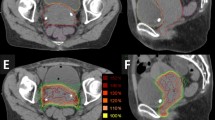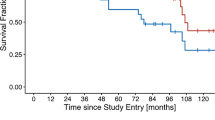Background and Purpose:
During radiotherapy of localized prostate cancer, organ movements for the dose exposure of organs at risk like rectum, urinary bladder and urethra play, inter alia, a significant role. One possibility of internal organ stabilizing is offered by the usage of a rectal balloon during radiotherapy. The influence on organ movements and dose allocation of the organs at risk is unknown.
Patients and Methods:
Twelve patients (Table 1) were characterized based on planning-CT's regarding organ movements and organ doses using a rectal balloon, inflated with 0 ml and 60 ml air. For the determination of the organ doses, three-dimensional conformal radiation plans (3-field-pelvis box) with a cumulative dose of 59.4 Gy were created, and the dose-volume-histograms for the anterior rectal wall, the posterior rectal wall, the rectal mucosa, the whole rectum, as well as the urinary bladder were compared (Figures 1 and 2).
Results:
The application of a 60 ml air-filled rectal balloon during each fraction of teletherapy led to significant organ movements of the anterior and posterior rectal wall and to a reduction of the transversal prostate diameter, as well as to a changed organ dose exposure of the organs at risk. A ventral shift of the anterior rectal wall (maximum 0.8 cm, mean 0.4 cm) was shown, as well as a dorsal shift of the posterior rectal wall (maximum 1.2 cm, mean 0.7 cm), associated with a transversal prostate diameter decrease (maximum 0.8 cm, mean 0.3 cm) (Table 2, Figure 3). The organ dose of the anterior rectal wall increased significantly (maximum 1.3 Gy, mean 0.5 Gy) during application of a rectal balloon, the one of the posterior rectal wall decreased significantly (maximum 18.6 Gy, mean 6.5 Gy). Related to the entire rectal mucosa and the rectum as a complete organ, a decrease of the maximum doses was shown (rectal mucosa: maximum 9.1 Gy, mean 3.0 Gy; rectum: maximum 9.4 Gy, mean 3.7 Gy). The organ dose of the urinary bladder did not show significant changes (Tables 3 and 4, Figures 4 to 7).
Conclusion:
The application of a rectal balloon in teletherapy of localized prostate cancer leads to significantly changed dose exposition of organs at risk. The decreased dose exposure of the posterior rectal wall and the rectal mucosa is opposed by the higher organ dose of the anterior rectal wall. It has to be shown weather documented organ dose exposure is associated with short and long-term consequences.
Hintergrund und Ziel:
Bei der Strahlentherapie des lokalisierten Prostatakarzinoms spielen unter anderem die Organbewegungen für die Dosisexposition der Risikoorgane Rektum, Harnblase und Harnröhre eine entscheidende Rolle. Eine Möglichkeit der internen Organstabilisierung stellt die Verwendung eines Rektumballons bei der Strahlentherapie dar. Der Einfluss auf die Organbewegungen und die Dosisverteilung an den jeweiligen Risikoorganen ist unklar.
Patienten und Methodik:
12 Patienten (Tabelle 1) wurden auf der Grundlage von Planungs-Computertomogrammen hinsichtlich Organbewegungen und Organdosen unter Verwendung eines Rektumballons mit 0 ml und 60 ml Luftfüllung charakterisiert. Für die Bestimmung der Organdosen wurden dreidimensionale konformale Bestrahlungspläne (3-Felder-Beckenbox) mit einer Gesamtdosis von 59,4 Gy erstellt und die Dosis-Volumen-Histogramme für die Rektumvorderwand, die Rektumhinterwand, die Rektumschleimhaut, das gesamte Rektum sowie die Harnblase verglichen (Abbildungen 1 und 2).
Ergebnisse:
Die Verwendung eines mit 60 ml Luft gefüllten Rektumballons bei der Teletherapie führte zu signifikanten Organbewegungen im Bereich der Rektumvorderwand, Rektumhinterwand und zu einer Reduzierung des transversalen Prostatadurchmessers sowie zu veränderten Organdosen der Risikoorgane. Es zeigte sich eine Ventralverschiebung der Rektumvorderwand (Maximum 0,8 cm, Mittel 0,4 cm) sowie eine Dorsalverschiebung der Rektumhinterwand (Maximum 1,2 cm, Mittel 0,7 cm), verbunden mit einer Reduktion des transversalen Prostatadurchmessers (Maximum 0,8 cm, Mittel 0,3 cm) (Tabelle 2, Abbildung 3). Die Organdosis der Rektumvorderwand nahm unter Verwendung eines Rektumballons signifikant zu (Maximum 1,3 Gy, Mittel 0,5 Gy), die der Rektumhinterwand signifikant ab (Maximum 18,6 Gy, Mittel 6,5 Gy). Bezogen auf die gesamte Rektumschleimhaut und das Rektum als Gesamtorgan zeigte sich eine Reduktion der Maximaldosen (Rektumschleimhaut: max. 9,1 Gy, Mittel 3,0 Gy, Rektum: maximal 9,4 Gy, Mittel 3,7 Gy). Die Organdosis der Harnblase zeigte keine signifikante Veränderung (Tabellen 3 und 4, Abbildungen 4–7).
Schlussfolgerung:
Die Verwendung eines Rektumballons bei der Teletherapie des lokalisierten Prostatakarzinoms führt zu signifikant veränderter Dosisexposition von Risikoorganen. Geringeren Organdosen an Rektumhinterwand und Rektumschleimhaut steht eine höhere Organdosis der Rektumvorderwand entgegen. Inwieweit die unterschiedlichen Organdosen einen Einfluss auf Akut- und Spätfolgen haben, muss Gegenstand weiterer Untersuchungen sein.
Similar content being viewed by others
Author information
Authors and Affiliations
Corresponding author
Rights and permissions
About this article
Cite this article
Elsayed, H., Bölling, T., Moustakis, C. et al. Organ Movements and Dose Exposures in Teletherapy of Prostate Cancer using a Rectal Balloon. Strahlenther Onkol 183, 617–624 (2007). https://doi.org/10.1007/s00066-007-1736-8
Received:
Accepted:
Issue Date:
DOI: https://doi.org/10.1007/s00066-007-1736-8




